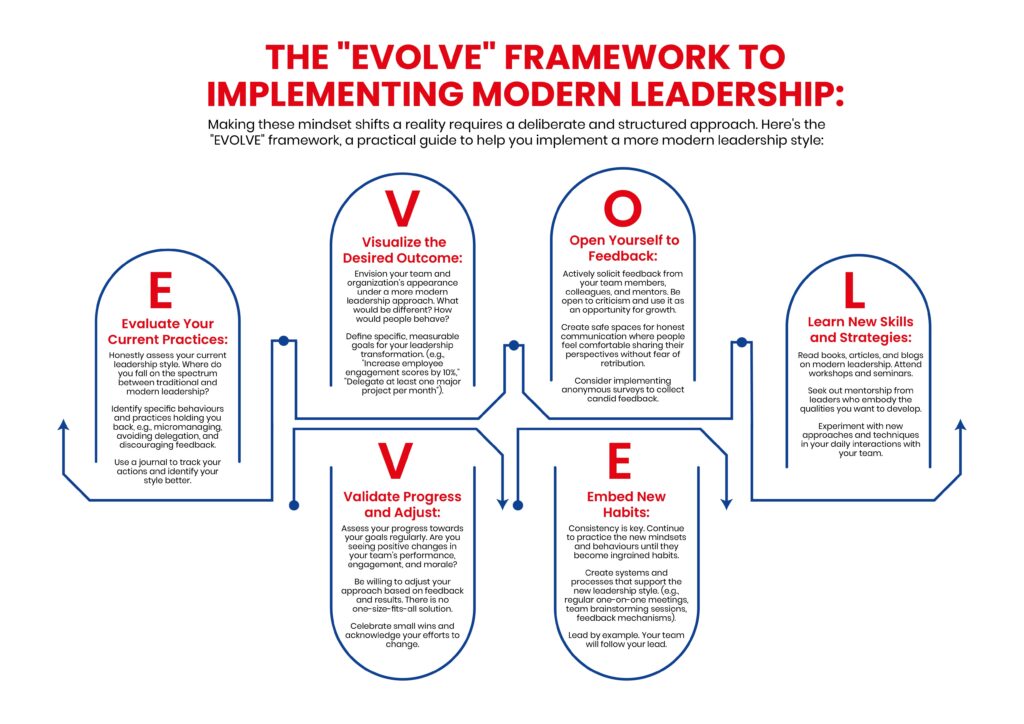You’ve led your teams and organizations with certain principles for years- perhaps decades – a traditional leadership model emphasizing hierarchy, control, and top-down decision-making. It may have served you well, delivering results and building a successful career.
But the world has changed. The rapid pace of technological advancement, shifting workforce demographics, and the rise of remote work have created a new landscape, one where the old rules of leadership no longer apply.
You might feel the pressure of decreased employee engagement, difficulty attracting and retaining top talent, or a sense that your team isn’t as agile and innovative as it needs to be. This isn’t a failure of your abilities; it’s a sign that it’s time for a shift – a transformation in your leadership mindset.

Why Traditional Leadership Mindsets are Holding You Back
The traditional leadership mindset is often characterized by several core beliefs and behaviors that, while once effective, are now becoming liabilities:
- Command and Control: The belief that the leader must control all aspects of the operation, make all major decisions and closely supervise employees. This stifles creativity, disempowers team members, and limits agility.
- Knowledge is Power, and I Have It: The assumption that the leader possesses the most knowledge and expertise leads to reluctance to seek input from others. This hinders innovation and prevents the organization from leveraging the team’s collective intelligence.
- Fear of Failure: A strong aversion to mistakes and a tendency to punish errors rather than learn from them. This creates a culture of fear, where employees are afraid to take risks or propose new ideas.
- Focus on Short-Term Results: Prioritizing immediate gains over long-term sustainability and employee well-being. This can lead to burnout, high turnover, and a lack of strategic vision.
- Resistance to Change: A reluctance to embrace new technologies, approaches, or ideas, clinging to familiar methods even when they are no longer effective. This limits adaptability and makes the organization vulnerable to disruption.
- Emotional Distance: Maintaining a professional distance from team members, suppressing emotions, and avoiding vulnerability. This creates a lack of trust and hinders authentic connection.
If you recognize any of these mindsets in yourself, it’s not a sign of weakness; it’s a sign that you’ve been operating within a system that, until recently, rewarded these behaviors. However, the modern workplace demands a different approach. Holding onto these traditional mindsets will increasingly limit your effectiveness and hinder your ability to lead your team to success.
Embracing a New Paradigm of Leadership:
Transitioning to a more modern leadership style requires a fundamental shift in mindset. Here are the key transformations to embrace:
- From Control to Empowerment: Instead of controlling every detail, focus on empowering your team members to take ownership and make decisions. This requires trust, clear communication, and necessary resources and support.
- From Knower to Learner: Shift from believing you have all the answers to embracing a continuous learning mindset. Be curious, seek out diverse perspectives, and be open to new ideas, even if they challenge your own.
- From Fear of Failure to Embracing Experimentation: Create a culture where mistakes are viewed as learning opportunities, not as failures to be punished. Encourage experimentation, innovation, and calculated risk-taking.
- From Short-Term to Long-Term Vision: Balance immediate needs with long-term strategic goals. Invest in employee development, foster a strong culture, and prioritize sustainable growth.
- From Resistance to Adaptability: Embrace change as an opportunity for growth and improvement. Be willing to experiment with new technologies, approaches, and working methods.
- From Emotional Distance to Vulnerability and Authenticity: Build genuine connections with your team members by being open, honest, and willing to show your human side. This fosters trust, strengthens relationships, and creates a more supportive environment.
- From “Me” to “We”: Instead of being a top-down, individual leader, become a team leader working with a shared vision.
These mindset shifts are not just about being a “nicer” leader but about being a more effective leader in today’s complex and rapidly changing world. They are about creating a more engaged, innovative, and resilient team that is capable of achieving extraordinary results. The shift can seem like a big ask, but implementing it doesn’t have to be.

The “EVOLVE” Framework to Implementing Modern Leadership:
Making these mindset shifts a reality requires a deliberate and structured approach. Here’s the “EVOLVE” framework, a practical guide to help you implement a more modern leadership style:
E – Evaluate Your Current Practices:
Honestly assess your current leadership style. Where do you fall on the spectrum between traditional and modern leadership? Identify specific behaviors and practices that are holding you back, e.g., micromanaging, avoiding delegation, and discouraging feedback. se a journal to track your actions and identify your style better.
V – Visualize the Desired Outcome:
Envision your team and organization’s appearance under a more modern leadership approach. What would be different? How would people behave? Define specific, measurable goals for your leadership transformation, e.g., “Increase employee engagement scores by 10%” or “Delegate at least one major project per month.”
O – Open Yourself to Feedback:
Actively solicit feedback from your team members, colleagues, and mentors. Be open to criticism and use it as an opportunity for growth. Create safe spaces for honest communication where people feel comfortable sharing their perspectives without fear of retribution. Consider implementing anonymous surveys to collect candid feedback.
L – Learn New Skills and Strategies:
Read books, articles, and blogs on modern leadership. Attend workshops and seminars. Seek out mentorship from leaders who embody the qualities you want to develop. Experiment with new approaches and techniques in your daily interactions with your team.
V – Validate Progress and Adjust:
Regularly assess your progress toward your goals. Are you seeing positive changes in your team’s performance, engagement, and morale? Be willing to adjust your approach based on feedback and results. There is no one-size-fits-all solution. Celebrate small wins and acknowledge your efforts to change.
E – Embed New Habits:
Consistency is key. Continue to practice the new mindsets and behaviors until they become ingrained habits. Create systems and processes that support the new leadership style e.g., regular one-on-one meetings, team brainstorming sessions, feedback mechanisms. Lead by example. Your team will follow your lead.
This framework provides a structured path for transforming your leadership style. It’s a journey, not a destination, and it requires ongoing commitment and effort.

Immediate Actions for Traditional Leaders to Start Today:
You don’t have to overhaul your entire leadership approach overnight. Here are some immediate, actionable steps you can take today to start shifting your mindset and behaviors:
1.Delegate a Task: Identify one task you typically handle yourself and delegate it to a team member. Provide clear instructions and support, but resist the urge to micromanage.
2.Ask for Feedback: At your next team meeting, ask your team members for one specific thing you could do to be a more effective leader. Listen actively and thank them for their honesty.
3.Practice Active Listening: In your next one-on-one conversation with a team member, focus entirely on listening to what they say without interrupting or formulating your response.
4.Admit a Mistake: If you make a mistake, acknowledge it openly and honestly to your team. Apologize if necessary and explain what you’ve learned.
5.Show Appreciation: Take the time to thank a team member for their hard work and contributions. Be specific about what you appreciate.
6.Schedule “Learning Time”: Block out 30 minutes in your calendar this week to read an article or watch a video on modern leadership.
7.Start a Leadership Journal: Reflect on your leadership and how you can make small changes in your daily life.
These small steps, taken consistently, will shift your mindset and create a ripple effect throughout your team and organization. Remember, leadership is not a title; it’s a way of being. It’s about continuous learning, growth, and adaptation.
Final Thoughts:
The transition from a traditional leadership mindset to a more modern, empowering approach is a journey that requires courage, self-awareness, and a willingness to change. It’s not about abandoning everything you’ve learned; it’s about building upon your strengths and adapting to the demands of a new era.
The mindset shifts and the EVOLVE framework outlined in this article provide a practical roadmap for this transformation. By embracing these changes, you can unlock your potential as a leader, create a more engaged and innovative team, and achieve tremendous success in today’s dynamic world. The benefits extend beyond improved performance; they encompass a more fulfilling and meaningful leadership experience.
Ready to embark on this journey of leadership transformation? Schedule a discovery call today to explore how to implement these principles and create a more effective and inspiring leadership style. Click here to book your call.










